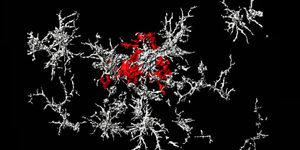Tracking phytoplankton to understand nutrient stress in the oceans
Researchers at the University of California, Irvine have developed a high-detail map to track phytoplankton in the ocean. Scientists say that monitoring populations of these tiny creatures is key to understanding ocean health and productivity. The map is part of a new initiative called Bio-GO-SHIP that involved deployments on research vessels in the Atlantic, Pacific, and Indian oceans to collect data. The team’s findings are published in the journal Science.
"Phytoplankton are foundational to the marine food web, and they are responsible for as much as half of global carbon dioxide fixation on an ongoing basis, so the health and distribution of these organisms is very important," said senior co-author Adam Martiny, UCI professor of Earth system science. "The knowledge gained on these voyages will help climatologists make more sound predictions about the role of phytoplankton in regulating carbon stocks in the atmosphere and ocean."
Over the course of 228 days at sea, the researchers collected almost nearly 1,000 ocean metagenomes from 930 locations around the globe. They focused their research particularly on a species of phytoplankton called Prochlorococcus, which they say can act as a biosensor for understanding “nutrient stress” throughout different regions in the oceans. Phytoplankton, like all living organisms, need specific nutrients (such as nitrogen, phosphorus, and iron) to survive. When these nutrients are limited, the organisms’ ability to grow and reproduce is affected.
"Nitrogen, phosphorus and iron limitation in many surface ocean regions is nearly impossible to detect through chemical analysis of water samples; the quantities of these elements are just too low," said lead author Lucas Ustick, a UCI graduate student in ecology & evolutionary biology. "But quantifying shifts in Prochlorococcus genes involved in the uptake of major nutrients, and combinations thereof provides a strong indicator of the geography of nutrient stress."
Prochlorococcus has the extremely handy genetic adaptation of being able to add a gene capable of absorbing dissolved organic phosphorus from the environment when inorganic phosphate (occurring naturally in seawater) is limited. This, in addition, to other genetic adaptations for changing levels of phosphorus, iron and nitrogen, allowed the researchers to track nutrient stress in the ocean through the consequential genomic shifts in the phytoplankton. In doing so, they found biogeographic patterns of nutrient stress that allowed them to create their map.
While their findings go far beyond any previous investigations, there is still much to learn, say the researchers. "Our work highlights gaps in our measurements of high-latitude environments, in most of the Pacific Ocean, and in deeper-water ecosystems," notes co-first author Alyse Larkin, UCI postdoctoral scholar in Earth system science. "The progress we made on our recent expeditions inspires us to head out and cover the whole planet."
Sources: Science, Science Daily








